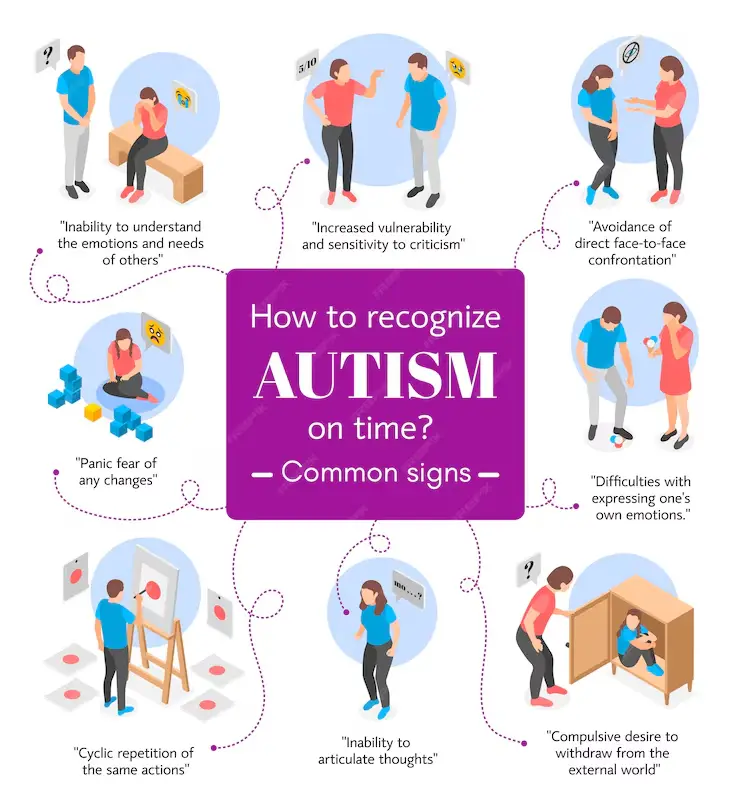Demystifying High-Functioning Autism, Navigating Strengths and Challenges

Introduction:
High-Functioning Autism (HFA) is a term often used to describe individuals on the autism spectrum who have average or above-average intellectual abilities and language skills, but still experience challenges in social interaction, communication, and sensory processing. While HFA shares core characteristics with autism spectrum disorder (ASD), understanding the unique features and experiences of individuals with HFA is essential for providing tailored support and promoting their well-being.

Page Contents
- 1 Demystifying High-Functioning Autism, Navigating Strengths and Challenges
- 2 Defining High-Functioning Autism:
- 3 4 Characteristics
- 4 4 Challenges and Strengths:
- 5 Living with High-Functioning Autism presents both challenges and strengths:
- 6 5 Support and Intervention:
- 7 Here are examples of support and intervention strategies for individuals with High-Functioning Autism (HFA):
- 8 Celebrating Diversity:

Defining High-Functioning Autism:
High-Functioning Autism is not an official diagnostic category within the DSM-5, but rather a descriptive term used to characterize a subgroup of individuals with ASD who exhibit the following certain characteristics below.
4 Characteristics
- Strong Intellectual Abilities: Individuals with HFA typically have average to above-average intelligence and may excel in specific academic or cognitive areas.
- Language Proficiency: Unlike some individuals with ASD who experience significant language delays, those with HFA often develop language skills at a typical age and may have advanced vocabulary and grammar.
- Difficulty in Social Interaction: Despite their cognitive strengths, individuals with HFA struggle with understanding social cues, forming friendships, and navigating social situations. They may have difficulty interpreting facial expressions, maintaining eye contact, and understanding unwritten social rules.
- Repetitive Behaviors and Special Interests: Like other individuals on the autism spectrum, those with HFA may engage in repetitive movements or behaviors and have intense, focused interests in specific topics or activities.

4 Challenges and Strengths:
Living with High-Functioning Autism presents both challenges and strengths:
- Social Challenges: Difficulty understanding social nuances and forming meaningful relationships can lead to feelings of isolation and loneliness for individuals with HFA. They may also face challenges in academic and professional settings that require strong social skills.
- Communication Differences: While individuals with HFA may have advanced language skills, they may struggle with pragmatic language (the social use of language), understanding non-literal language (e.g., sarcasm, idioms), and engaging in reciprocal conversation.
- Sensory Sensitivities: Many individuals with HFA experience sensory sensitivities, such as heightened sensitivity to noise, light, textures, or smells. These sensitivities can be overwhelming and affect daily functioning.
- Special Interests and Talents: Individuals with HFA often have intense, focused interests in specific topics, which can lead to deep expertise and exceptional abilities in those areas. Embracing and nurturing these talents can foster a sense of purpose and fulfillment.
5 Support and Intervention:
Effective support for individuals with High-Functioning Autism involves a multidisciplinary approach that addresses their unique needs and strengths:
- Social Skills Training: Targeted interventions can help individuals with HFA improve their social communication skills, understand social cues, and navigate social interactions more effectively.
- Cognitive Behavioral Therapy (CBT): CBT techniques can be helpful in addressing anxiety, depression, and other mental health challenges commonly experienced by individuals with HFA.
- Sensory Integration Therapy: Occupational therapy techniques can help individuals with HFA manage sensory sensitivities and develop coping strategies for sensory overload.
- Educational Accommodations: Providing accommodations and supports in educational settings, such as preferential seating, additional breaks, or social skills groups, can help individuals with HFA succeed academically.
- Employment Support: Offering workplace accommodations and opportunities for individuals with HFA to utilize their strengths and talents can facilitate successful employment outcomes.
Here are examples of support and intervention strategies for individuals with High-Functioning Autism (HFA):
- Social Skills Training:
- Group therapy sessions focusing on social communication skills, such as turn-taking, initiating conversations, and understanding nonverbal cues.
- Role-playing exercises to practice social interactions and problem-solving scenarios.
- Social stories and visual supports to help individuals understand social expectations and navigate social situations.
- Cognitive Behavioral Therapy (CBT):
- Cognitive restructuring techniques to address maladaptive thoughts and beliefs related to social anxiety or sensory sensitivities.
- Relaxation techniques, such as deep breathing and progressive muscle relaxation, to manage stress and anxiety.
- Exposure therapy to gradually desensitize individuals to anxiety-provoking situations or sensory stimuli.
- Sensory Integration Therapy:
- Sensory diets consisting of sensory activities tailored to the individual’s sensory preferences and sensitivities.
- Use of sensory tools and equipment, such as weighted blankets, fidget toys, or noise-canceling headphones, to regulate sensory input.
- Environmental modifications to create sensory-friendly spaces at home, school, or work, such as reducing fluorescent lighting or providing quiet areas for breaks.
- Educational Accommodations:
- Individualized Education Plans (IEPs) or 504 Plans outlining specific accommodations and supports in educational settings, such as extended time on tests, preferential seating, or access to assistive technology.
- Utilization of visual supports, such as visual schedules, picture schedules, and visual task lists, to enhance organization and comprehension.
- Collaborative efforts between educators, parents, and support staff to create inclusive learning environments and implement evidence-based teaching strategies.
- Employment Support:
- Job coaching and vocational training programs to develop job-related skills, such as time management, task completion, and workplace communication.
- Workplace accommodations, such as flexible scheduling, modified job duties, or sensory-friendly workspaces, to support individuals with HFA in their employment.
- Sensitivity training for employers and coworkers to increase awareness and understanding of autism-related strengths and challenges in the workplace.
- Family Support and Counseling:
- Family Counseling and Psychoeducation to help family members understand and support the individual with HFA.
- Parent training programs to teach effective behavior management strategies and communication techniques.
- Respite care services to provide temporary relief for caregivers and promote family well-being.
These support and intervention strategies aim to address the unique needs and strengths of individuals with High-Functioning Autism, promoting their social, emotional, and academic success while enhancing their overall quality of life.
Celebrating Diversity:
High-Functioning Autism (HFA) represents a diverse and multifaceted experience, characterized by a combination of challenges and strengths. By fostering understanding, acceptance, therapy and support for individuals with HFA or Highly Functioning Autism, we can create inclusive communities where everyone has the opportunity to thrive and contribute their unique perspectives and talents.






